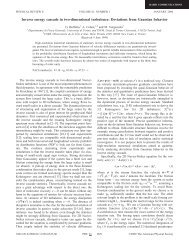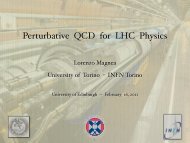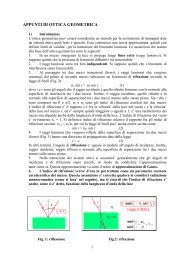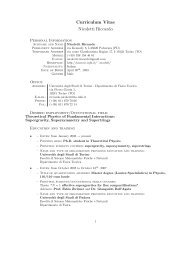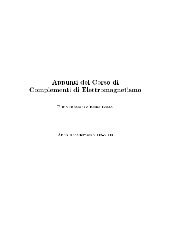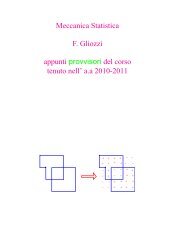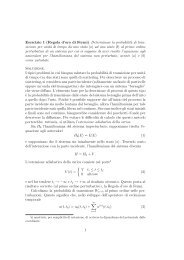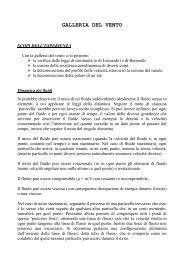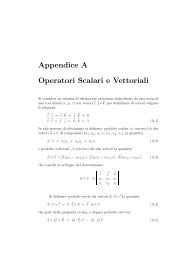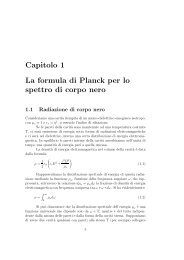conviene innanzi tutto farne una riduzione a spinori a due componenti, ossia scrivere( ) χ(x)ψ(x) = , (5.27)ϕ(x)per ottenere, con passaggi analoghi a quelli del paragrafo 4.5, in rappresentazione <strong>di</strong> Dirac{ ( )c ⃗σ ·⃗p ϕ(x) = E − V − m c2χ(x) ,c ⃗σ ·⃗p χ(x) = ( E − V + m c 2) (5.28)ϕ(x) .È conveniente scrivere la χ(x) e la ϕ(x) me<strong>di</strong>ante le seguenti fattorizzazioni:{χ = g(r) Y jlχj 3,ϕ = i f(r) Y jlϕj 3,(5.29)dove le funzioni Y jlj 3sono le funzioni ortonormali <strong>di</strong> angolo-spin (autofunzioni <strong>di</strong> ⃗ J 2 , J 3 ,2⃗ L , S ⃗ 2 )Y jlj 3= ∑〈l m l s m s |j j 3 〉 Y l,ml χ s,ms . (5.30)m l ,m sQuando sostituiamo le (5.29) nelle (5.28) dobbiamo saper valutare il risultato dell’applicazionedell’operatore ⃗σ ·⃗p sugli spinori χ e ϕ. Riscriviamo allora quest’operatore nelmodo seguente:⃗σ ·⃗p =⃗σ ·⃗rr 2 (⃗σ ·⃗r) (⃗σ ·⃗p) ,(⃗σ ·⃗r) (⃗σ ·⃗p) = ⃗r ·⃗p + i ⃗σ · (⃗r ×⃗p) = −i r ∂ ∂r + i ⃗σ · ⃗L ,(⃗σ ·⃗r⃗σ ·⃗p = −i r ∂ )+ i ⃗σ · ⃗L . (5.31)r 2 ∂rSi ottiene quin<strong>di</strong>, per esempio,(⃗σ ·⃗r⃗σ ·⃗p ϕ = i − r ∂ r 2 ∂r(⃗σ ·⃗r df= Y jlϕjr 3dr)+ ⃗σ · ⃗L+(1 − κ)r(⃗σ ·⃗rϕ = i − r ∂ )r 2 ∂r − (1 − κ) ϕ)f . (5.32)Notiamo ora che il risultato dell’applicazione dell’operatore ⃗σ ·⃗r (invariante per rotazione<strong>di</strong> spazio, ma pseudoscalare per riflessione spaziale) sulla funzione Y jlϕj 3(autofunzione<strong>di</strong> ⃗ J 2 , J 3 , ⃗ L 2 con autovalori 2 j(j + 1), j 3 , 2 l ϕ (l ϕ + 1)) dev’essere quello <strong>di</strong> generareun’autofunzione Y jlj 3<strong>di</strong> ⃗ J 2 , J 3 , ⃗ L 2 . Gli autovalori <strong>di</strong> quest’ultima per ⃗ J 2 e J 3 sono glistessi della Y jlϕj 3, mentre il valore <strong>di</strong> l deve avere una parità opposta a quella <strong>di</strong> l ϕ , acausa del cambiamento <strong>di</strong> parità indotto dalla natura pseudoscalare <strong>di</strong> ⃗σ ·⃗r. Deve quin<strong>di</strong>essere l = l χ (per una <strong>di</strong>mostrazione analitica <strong>di</strong> questa proprietà, si veda l’Appen<strong>di</strong>ceF). Possiamo allora scrivere⃗σ ·⃗rrY jlϕj 3= η 1 Y jlχj 3, (5.33)50
dove η 1 è un fattore <strong>di</strong> fase (dal momento che le funzioni Y jlj 3sono normalizzate e ( )⃗σ·⃗r 2r =1). Analogamente, si deve avere⃗σ ·⃗rrY jlχj 3= η 2 Y jlϕj 3. (5.34)Per compatibilità tra le due equazioni (5.33) e (5.34), dev’essere η 1 η 2 = +1. Definendoopportunamente la fase relativa tra le due funzioni Y jlϕj 3e Y jlχj 3, che è arbitraria, possiamoscegliere η 1 = η 2 = −1. Abbiamo quin<strong>di</strong>⃗σ ·⃗rrY jlχj 3= −Y jlϕj 3,⃗σ ·⃗rrY jlϕj 3= −Y jlχj 3. (5.35)Sostituendo la prima <strong>di</strong> queste espressioni nella (5.32) otteniamo( df⃗σ ·⃗p ϕ = −dr + 1 − κ )f Y jlχjr3. (5.36)Analogamente si ha( dg⃗σ ·⃗p χ = i dr + 1 + κ )g Y jlϕjr3. (5.37)Usando queste relazioni, le equazioni del moto (5.28) <strong>di</strong>ventano⎧⎪⎨⎪⎩( df− cdr + 1 − κ )f = ( E − V − m c 2) g ,r( dg cdr + 1 + κ )g = ( E − V + m c 2) f .r(5.38)Il problema è stato quin<strong>di</strong> ricondotto a quello del calcolo delle funzioni d’onda ra<strong>di</strong>ali f(r)e g(r), una volta che sia stata precisata la forma funzionale del potenziale V (r). Come sivede, anche nel caso dell’equazione <strong>di</strong> Dirac, un potenziale centrale consente la separazionenella funzione d’onda tra <strong>di</strong>pendenza angolare (e <strong>di</strong> spin) e <strong>di</strong>pendenza ra<strong>di</strong>ale. Unaimportante <strong>di</strong>fferenza con il caso dell’equazione <strong>di</strong> Schrö<strong>di</strong>nger è che adesso abbiamodue equazioni <strong>di</strong>fferenziali ra<strong>di</strong>ali accoppiate, anzichè una sola equazione. Normalmenteconviene ridefinire le due funzioni ra<strong>di</strong>ali come segue:F (r) = r f(r) , G(r) = r g(r) , (5.39)e quin<strong>di</strong> si ha⎧⎪⎨⎪⎩( dF cdr − κ )r F = − ( E − V − m c 2) G ,( dG cdr + κ )r G = ( E − V + m c 2) F .(5.40)51
- Page 1:
Lezioni diMeccanica Quantistica Rel
- Page 4 and 5:
4.3 Invarianza di gauge . . . . . .
- Page 7 and 8: Capitolo 1Equazione di Dirac1.1 Int
- Page 9 and 10: con la quadri-correntej µ =i2 m [
- Page 11 and 12: Passiamo ora all’esame dell’equ
- Page 13 and 14: 1.2.2 Prodotti di matrici γ: matri
- Page 15 and 16: È evidente che in un cambiamento d
- Page 17 and 18: Assumendo che le funzioni d’onda
- Page 19 and 20: dove⎛⎞(r 1 ) µ ν = d(R 1) µ
- Page 21 and 22: Poichè γ 0 γ µ† γ 0 = γ µ
- Page 23 and 24: per inversione temporale si ottiene
- Page 25 and 26: 4. Γ a = γ µ γ 5 .ψ ′ (x ′
- Page 27 and 28: Scrivendou(0) =( )χ+ (0)ϕ + (0)(2
- Page 29 and 30: dove C è una opportuna costante di
- Page 31 and 32: Esplicitamente si ha⎛ ( ) ⎞√
- Page 33 and 34: ∫Per la normalizzazione in un vol
- Page 35 and 36: eΛ + (⃗p) soddisfa anche la prop
- Page 37 and 38: cone quindiΩ ′ = γ 0 Ω † γ
- Page 39 and 40: si ottiene⃗ J = ⃗ L +12 ⃗ Σ
- Page 41 and 42: ◮ Momento angolare di spin ⃗ Σ
- Page 43 and 44: Nella scrittura di queste equazioni
- Page 45 and 46: a sinistra per γ 0 , otteniamo(i
- Page 47 and 48: Da[π j , π k] = [ p j − eA j ,
- Page 49 and 50: Infatti∫∫d 3 x X † X =( ) ( (
- Page 51 and 52: 4. − e 28 m 2 c 2 ⃗ ∇ · ⃗E
- Page 53 and 54: Poiché Σ k = −γ 0 γ k γ 5 ,
- Page 55: Osserviamo ora che χ e ϕ, essendo
- Page 59 and 60: PonendoF ∼ c ρ s , G ∼ c ′
- Page 61 and 62: n ′ j κ l nnotazionespettroscopi
- Page 63 and 64: *)EF-GIHKJ(LMN)*¥¨§ ¥¨§ ¥¨
- Page 65 and 66: si ha∆E hfn=1 (trip-sing) = 8 3 (
- Page 67 and 68: £ £ £ £ £¢¤ £ £E 2×✻✁
- Page 69 and 70: ✻+ ♠♠−✛✘✛ + ♠ −
- Page 71 and 72: Capitolo 7Spinori chirali7.1 Autofu
- Page 73 and 74: Queste sono le due equazioni del mo
- Page 75 and 76: Analogamente, si ottiene che il val
- Page 77 and 78: (' "!¢ ¡¢ ¡¢ ¡¢ ¡¢
- Page 79 and 80: dove è stato omesso un possibile f
- Page 81 and 82: Le stesse proprietà valgono per i
- Page 83 and 84: La funzioneK(t ′ ,⃗x ′ ; t,
- Page 85 and 86: Im p 0✻✲−E ✲✚✙C F✲✛
- Page 87 and 88: ¥££ £££ £¢ £¡£ ¤¥§¦
- Page 89 and 90: Quindi, la probabilità di transizi
- Page 91 and 92: Appendice AUnità naturaliIn unità
- Page 93 and 94: Perciòg µν = g µν =⎛⎜⎝1
- Page 95 and 96: InfattiTr ( (γ µ ) 2 γ 5) = −T
- Page 97 and 98: Analogamente, utilizzando la (D.4)
- Page 99 and 100: Notare cheS † C = ˜S C = S −1C
- Page 101 and 102: 4) Γ a = γ µ γ 5 .ψ ′ (x ′
- Page 103 and 104: Poichè ϕ è un’autofunzione del
- Page 105 and 106: perchè δϕ α = 0 sull’iper-sup
- Page 107 and 108:
Appendice HRappresentazione integra
- Page 109:
Appendice ICalcolo di sezioni d’u




